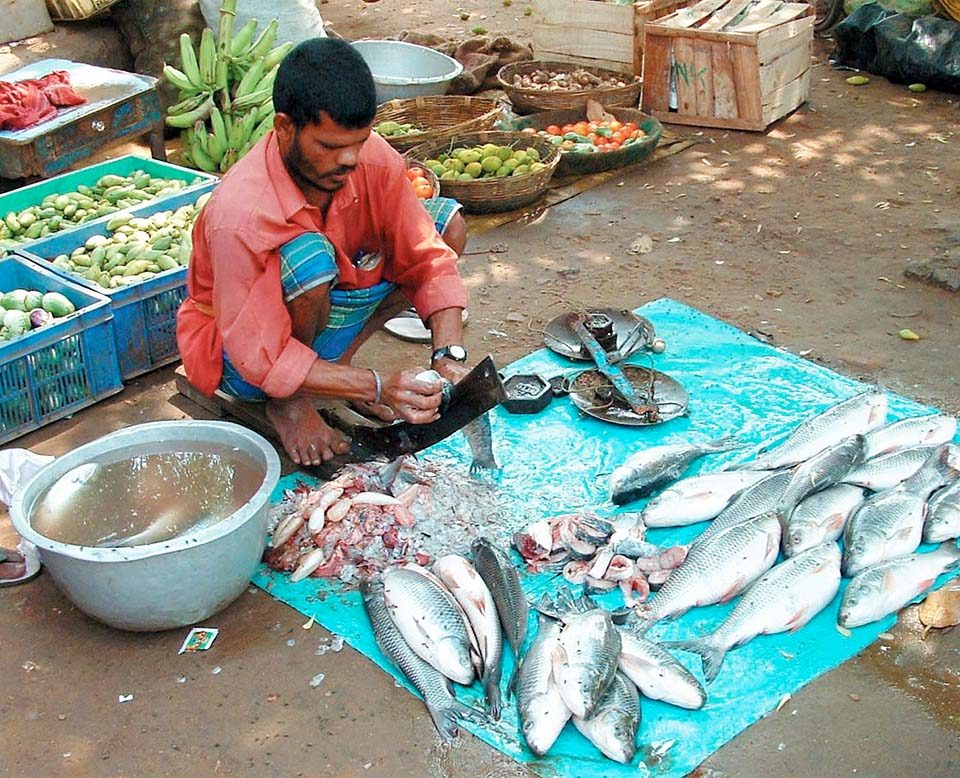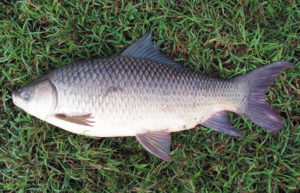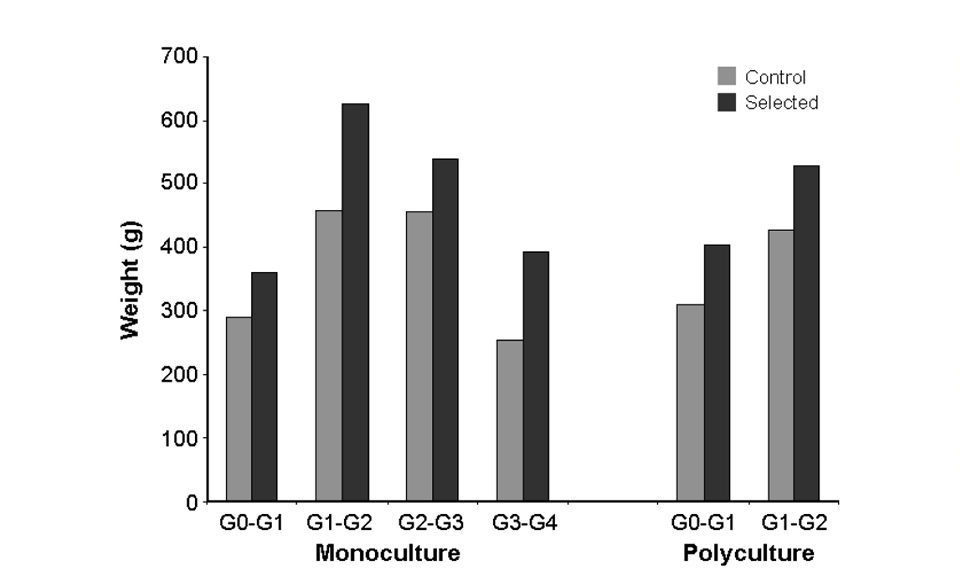Collaborative research project with CIFA in India and AKVAFORSK in Norway

With a population of 1.04 billion and annual growth of about 18 million, India sets major demands for increased food production. But the availability of land and water resources is depleting day by day. Therefore, an increase in unit-area productivity is strongly required to meet the country’s food requirements.
During the last 10 years, India has doubled its production of freshwater fish to 2 million metric tons (MT) per year. The production is mainly based on the carp species catla (Catla catla); rohu (Labeo rohita); and mrigal (Cirrhinus mrigala); each of which amounts to about 500,000 MT per year.
Carp are typically produced in 0.1- to 20-hectare ponds with depths up to 1.5 meters. Polyculture with three to six species in the same pond is the common farming practice. Some farmers also practice monoculture, particularly with rohu, which enjoys a high consumer preference in many states.
Extensive production
The average production level of farmed fish in India is about 2,000 kilograms per hectare pond area. Half of this production is based on the phytoplankton and zooplankton naturally produced in ponds, while the remainder is based on supplementary feed such as ground nut oil cake mixed with rice bran. In more intensive systems, production can reach 10 to 15 MT per hectare.
Feed conversion is generally low, mainly due to inadequate feed and feeding technology. Often more than 2 kg of dried feed is required to produce 1 kg of fish. Thus, there is great potential for increased production within present pond area and feed resources. In addition, there is great untapped potential for cage culture in large water reservoirs.
Inbreeding problems

Genetic improvement through selective breeding has until recently not been applied in Indian aquaculture. Consequently, there is a lack of knowledge and awareness among fishery scientists and fish farmers of the great potential of selective breeding as a means to improve productivity and efficiency.
Furthermore, hatcheries follow few genetic norms in the production of seed. The result is fry with low survival and growth – a problem partly linked to the great reproduction of carp. Often few parental fish are used in the production of new generations, which results in inbreeding depression and reduced performance for important traits like growth and survival.
To make up for these negative effects, fish farmers occasionally catch wild carp from the rivers and breed them with their own broodstock. This reduces the level of inbreeding in the population, but at the same time counteracts the positive effects of the natural selection for growth and other desired traits.
The situation suggests a need for better procedures for seed production, and that the presently farmed stocks may not be the best base material for genetic improvement.
Varied rohu stocks
To improve the rohu through selective breeding, a collaborative research project between Central Institute of Freshwater Aquaculture (CIFA) in India and Institute of Aquaculture Research (AKVAFORSK) in Norway was carried out 1992-2003 with funds provided by the Norwegian Agency for Development Cooperation. Fingerlings from five different riverine strains in India were brought to CIFA in Orissa. A farmed local stock reared at CIFA that originated from the Mahanadi River was also included.
Test environments
The growth and survival of the base population of pure stocks, crosses between the stocks, and a high number of full- and half-sib families were compared in monoculture and polyculture farming systems at CIFA. In polyculture, rohu were reared with mrigal and catla carp. Nine year-classes were produced with a total of 412 full-sib families and 18,000 individually tagged fish.
Selection for increased growth has been carried out for four generations. Selected fish and nonselected control fish from three of the last year-classes were tested under commercial conditions in monoculture in the states of Orissa, Andra Pradesh, West Bengal, and Punjab – major regions for carp production in India.
Similar performance
Consistently the wild stocks performed equal to or better than the farmed local stock for growth and survival. The pure stocks, crosses, and full-sib families ranked very similar for harvest body weight in monoculture and polyculture. The development of specialized varieties for each of the two production environments is therefore not required.
Negligible heterosis
For growth and survival, the difference between purebred and crossbred offspring was negligible, suggesting low heterosis. It was therefore concluded that genetic improvement through crossbreeding of rohu stocks had no practical significance.
Genetic variation
The data recorded for the full- and half-sib families revealed a substantial additive genetic variation for both survival and growth, showing that both traits can be improved through selective breeding. The realized selection response per generation for harvest body weight was substantial in both production environments: 31 percent in monoculture and 27 percent in polyculture (Fig. 1). This was also verified in all four states in monoculture. For unknown reasons, the observed selection responses significantly exceeded the theoretical expectations.

Fast-growing fish utilize available pond area, feed, and water resources more efficiently than slower-growing fish, allowing more fish to be produced with a given amount of resources. Alternatively, the current production can be obtained with fewer resources.
Increased resource efficiency
The project showed that selective breeding is an important technology to increase productivity and resource efficiency in Indian aquaculture. Multiplier units are established in Andhra Pradesh, West Bengal, and Orissa to ensure that the genetically improved seed reaches the rohu farmers in these states. Additional multiplier units will be established in other states. The organization of this work for rohu can also serve as a model for other carp species in India.
Note: This article is adapted from a longer version published in the January 2005 issue of INFOFISH International.
(Editor’s Note: This article was originally published in the February 2005 print edition of the Global Aquaculture Advocate.)
Now that you've finished reading the article ...
… we hope you’ll consider supporting our mission to document the evolution of the global aquaculture industry and share our vast network of contributors’ expansive knowledge every week.
By becoming a Global Seafood Alliance member, you’re ensuring that all of the pre-competitive work we do through member benefits, resources and events can continue. Individual membership costs just $50 a year. GSA individual and corporate members receive complimentary access to a series of GOAL virtual events beginning in April. Join now.
Not a GSA member? Join us.
Authors
-
Bjarne Gjerde, Ph.D.
AKVAFORSK (Institute of Aquaculture Research)
N-1432 Ås, Norway -
Kanta Das Mahapatra, Ph.D.
Central Institute of Freshwater Aquaculture
Orissa, India -
Ranjit K. Jana, Ph.D.
Central Institute of Freshwater Aquaculture
Orissa, India -
Jatendra N. Saha, Ph.D.
Central Institute of Freshwater Aquaculture
Orissa, India -
Morten Rye, Ph.D.
AKVAFORSK Genetics Center
Sunndalsøra, Norway
Related Posts

Aquafeeds
A look at India’s fish feed industry
India's fish-farming industry makes limited use of modern feeds, providing potential for the feed sector to grow. Commercial feeds are predominantly used for pangasius farming, followed by a rising popularity in carp culture.

Responsibility
A look at integrated multi-trophic aquaculture
In integrated multi-trophic aquaculture, farmers combine the cultivation of fed species such as finfish or shrimp with extractive seaweeds, aquatic plants and shellfish and other invertebrates that recapture organic and inorganic particulate nutrients for their growth.

Aquafeeds
A look at phospholipids in aquafeeds
Phospholipids are the major constituents of cell membranes and are vital to the normal function of every cell and organ. The inclusion of phospholipids in aquafeeds ensures increased growth, better survival and stress resistance, and prevention of skeletal deformities of larval and juvenile stages of fish and shellfish species.

Health & Welfare
Advances in fish hatchery management
Advances in fish hatchery management – particularly in the areas of brood management and induced spawning – have helped establish aquaculture for multiple species.


